
A car company’s line-up can sometimes be a little like a cricket squad’s batting order.
Each car is there to perform a task, ideally with each model complementing the others.
In Mitsubishi’s case, its openers are clearly the Outlander and Triton, the former having led the company to a position where it could be the country’s top passenger car brand by the end of the year.
Third in the order, a real Brendon McCullum type, used to be the ASX – a model eternally popular with fleets and still mightily popular today.
But, this year the ASX has been dropped down the batting order to fourth to make way for the Eclipse Cross. And we can thank the Clean Car Discount and a change in customer attitudes for that.
The range
Mitsubishi offers the Eclipse Cross in pure petrol forms starting at $36,990 (the similarly sized ASX starts at nine grand less), but the nameplate’s plug-in hybrids do the bulk of the heavy lifting.
The Eclipse Cross PHEV is available in two trims, the $52,990 XLS and the $59,990 VRX pictured here.
Both are eligible for a Clean Car Discount rebate of $5750, meaning one could sit on your driveway for well under 50 grand. Both are also exclusively four-wheel drive, unlike their petrol cousins.
It’s worth noting that the Eclipse Cross PHEV has had a few recent price hikes, having been launched at $49,990 for the XLS and $57,990 for the VRX.
Technical
The plug-in Cross borrows its powertrain from the outgoing Outlander PHEV, meaning it makes use of a familiar 2.4-litre petrol four-cylinder paired to dual electric motors and good for 94kW and 199Nm.
This is paired to a 13.8kWh battery, helping the Eclipse Cross achieve a quoted 55km pure electric range.
Charging comes via a Type 2 AC port for home charging and a Chademo plug for public charging. Chademo remains a popular choice among Japanese brands, but is expected to be phased out in the long term in favour of CCS fixtures.
The system comes with a 3.7kW AC limit, meaning a full charge at home will take seven hours on an old-school three-pin plug or four hours via a 7kW wallbox.
Meanwhile, its somewhat meagre 22kW DC charging capacity means it can charge from empty to 80% in around 25 minutes.
Launching in 2018 as Mitsubishi’s freshest-faced model against a backdrop of ageing peers, the Eclipse still manages to feel mostly fresh thanks to its future-focused PHEV powertrain and a helpful mid-life facelift implemented last year.
The Eclipse sits one weight division south of the Outlander, being 165mm shorter in length and 57mm narrower. Its wheelbase is a little more comparable, shrinking by just 36mm. This means a little less compromise when it comes to second-row legroom.

The Drive
Drivers familiar with either the outgoing or current Outlander PHEV will note that the smaller Eclipse picks up most of the same habits.
The electrified powertrain is mostly silent (unless you’re out of juice), while also being deceptively quick thanks to the instant torque.
I say deceptive because the Eclipse’s 94kW/199Nm outputs are paltry on paper. In reality, it’s more than capable of getting out of its own way and holding its own.
Drivers are unlikely to come close to Mitsubishi’s quoted 55km pure EV range. A number in the low 30km window is much more likely.
Equalling the brand’s 2.1 litres/100km economy is far more reachable. In our week with the model, the petrol needle barely shifted from full.
Mitsubishi clearly prioritises comfort with all its core SUV offerings. Like the Outlander, the Eclipse Cross rides extremely softly.
Perhaps too soft in some cases, with wobbly rebound being an occasional bugbear when coming off big speed bumps or evading potholes.
It generates a surprising amount of wind roar, and its attractive tapered glasshouse and generous C-pillar mean it’s not quite as easy to see out of as the Outlander.
Still for the most part, the Eclipse is mighty comfy and pleasant in daily commuting duty. Few in this size class can
boast the same levels of muted refinement since few offer a similar level of electrification.
Inside

The Eclipse Cross’ cabin is starting to show its age, particularly when compared to its Outlander stablemate.
Its eight-inch touchscreen would appreciate an upgrade. Ditto for its grainy reverse camera.
Still, it’s worth underlining that in typical Mitsubishi fashion, things all work fairly well.
Regular “if it ain’t broke” preachers will be more than happy inside the Eclipse. The conventional button layout is a breeze to grasp, and both the dash and door cards are chock full of soft-touch finishes.
Second row passengers are reasonably well looked after with handy levels of legroom and headroom. In this VRX trim, they even get heated rear seats on the flanks, a feature normally reserved for proper premium competitors.
Boot space takes a bit of a hit, dropping from 405 litres in pure petrol models to 359 in the PHEV. This is thanks to an elevated floor that makes room for the battery and a charger cable storage cubby.
Our view
Mitsubishi has sold plenty of Eclipse Cross PHEVs in 2022 for good reason.
It’s a vehicle without many real peers beyond its Outlander big brother, and the presence of a tried-and-true petrol
component makes it an attractive proposition for people wanting to dip their toes in the electrification movement.








